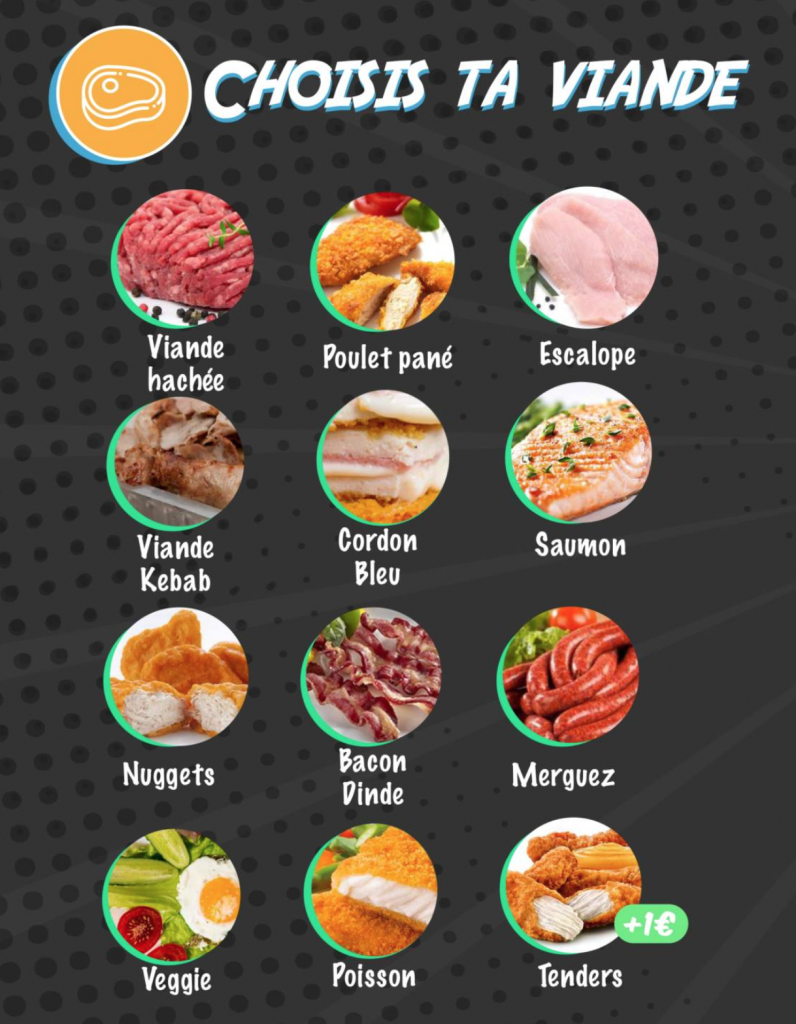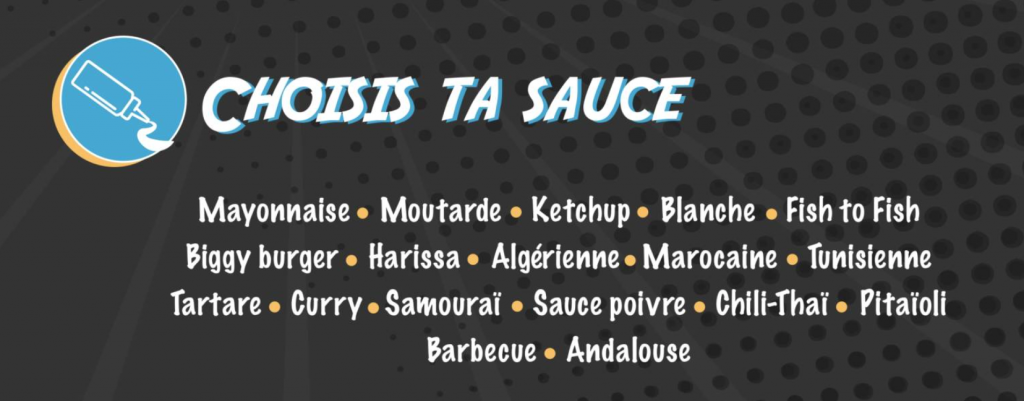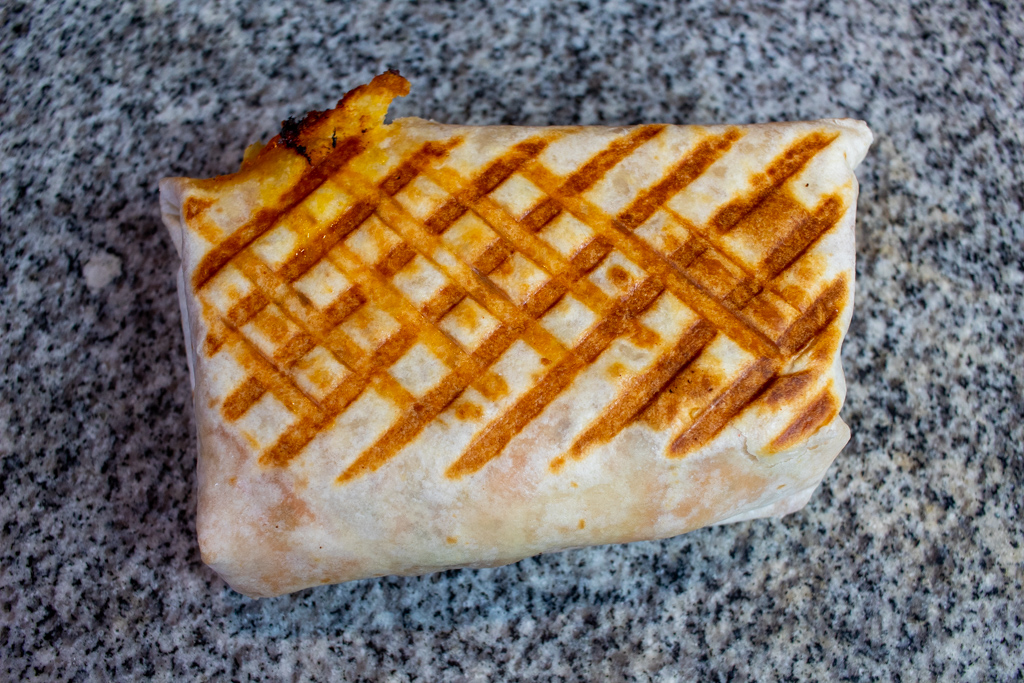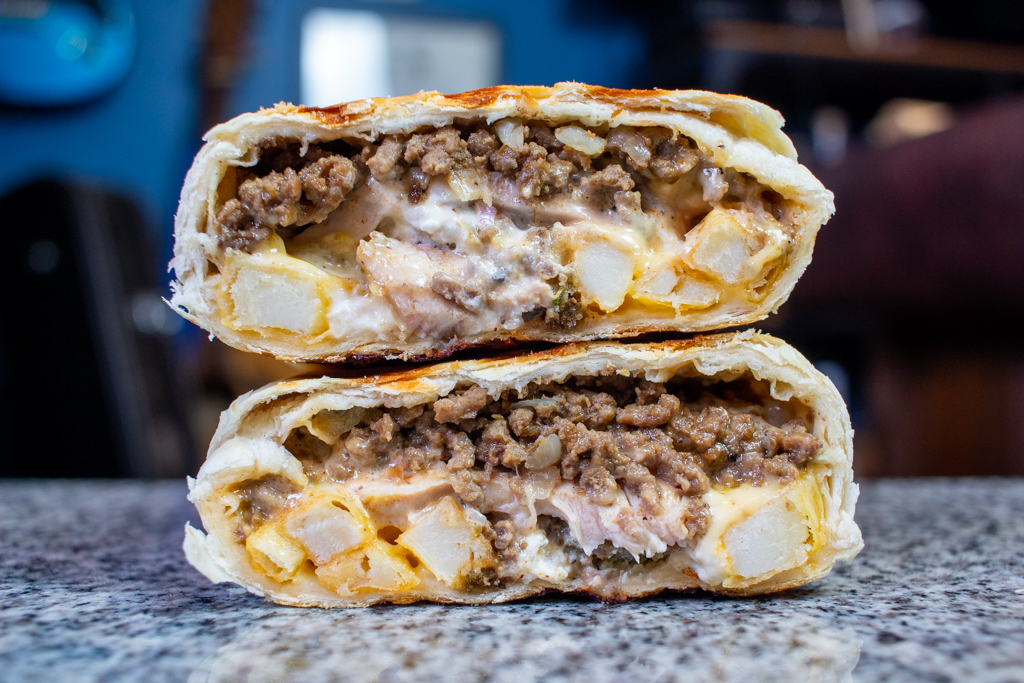Haute Cocina – French Tacos of Lyons
Dig if you will a picture: a globe, upon which the many paths of the evolution of the doner kebab have been traced in colored pen. One color would reach up into Germany and then radiate kaleidoscopically to points around the world. There would be short beams landing at points around Europe and northern Africa and longer sweeping arcs touching down in Oceania and in Asia, wherever doner kebab stands have become part of the street food landscape. Another primary trunk might swoop down into Greece, with limbs splitting off and infesting both the US, as Greek gyros, and Canada, as Donair. A third would stretch east, down through the Levant, around the Middle East and into Egypt, where shawarma and falafel are among the crown jewels of street food culture. This arm also would send tendrils into the Puebla state of Mexico, where Lebanese immigrants adapted shawarma into tacos arabes and tacos al pastor. The strands of the root doner kebab and the shawarma offshoots might be wound tightly together in near-indistinguishable braids at times. By the time all the paths had been traced, the lines colored in, it might well look like a child had scribbled a nightmarish fractal octopus strangling the globe in its embrace–a curious pose for such an animal to strike.
Perhaps the most interesting path any of those octopus arms traveled would be this: picture a line reaching east from Istanbul, down through Syria, Lebanon, Israel, then over into Egypt, making its way across the Maghreb until it reached Morocco, then shooting up into France, sneaking across the Atlantic to pick Mexico’s pocket and across the Alps to peek over Italy’s shoulder, and finally, from its Rhône-Alpes foothold, finding its way back down into Morocco and Algeria. This is the path that French Tacos took in becoming the street food Frankenstein they are today. Invented in the Lyon area in southeastern France in the mid-2000s by Moroccan kebab shop owners, the French Tacos–yes, in this case “tacos” is singular–consists of kebab shop style fillings and sauces, French fries, cheese, and in some cases a small amount of salad, wrapped burrito-style in a flour tortilla, then grilled in a panini press and served hot, crisp, and wrapped in wax paper. It is not very taco-like, nor is it very French, though the fromage may beg to differ.
The Process
The ordering method for a French Tacos, to me, appears very much like the American “fast casual” concepts springing up all over the place that I’ve been complaining about for the past several years, at least until the pandemic slowed down their insidious spread (too small a benefit, too dark a cloud to call it a silver lining). It’s a Chipotle workflow, if you will. I’ve taken a few screenshots of the online menu for one French Tacos chain, Le Tacos de Lyon, to demonstrate. First one chooses the size of one’s French Tacos, which will impact how many other fillings can be added.

Next is the choice of viande, or “meat,” though there are often meatless protein options available. This menu offers the following options: Ground meat, breaded chicken, chicken cutlet, kebab meat, chicken cordon bleu, salmon, chicken nuggets, turkey bacon, merguez sausage, vegetarian, fish, or chicken tenders.

This menu also offers these extras–peppers, chorizo, bacon, lardons, a fried egg, olives, goat cheese, melty Swiss Raclette cheese, mozzarella, Emmental cheese (a type of Alpine cheese, what we generally think of as “Swiss” cheese), creamy Boursin cheese, bleu cheese, Reblochon (another kind of Alpine cheese), or Cheddar.

Finally, there is a wide variety of sauces to choose from. This menu lists some standards: mayonnaise, mustard, ketchup. Then things get interesting. First up is “white” sauce–like the white yogurt-based garlic sauce offered by “Halal Guys” type kebab stands; “Fish to Fish” sauce, about which I’m not entirely sure but it appears to be similar to a mild remoulade variant; “Biggy burger” sauce, which also looks like a remoulade with mustard added; Harissa, a north African hot sauce; Algerian sauce, which is a mixture of mayonnaise and ketchup with finely minced onions and Ras el Hanout; Moroccan sauce, for which I have found multiple completely different recipes–is it tomato based? Yogurt based? I cannot say; Tunisian sauce, which may be tomato based but who knows? Tartar sauce, which one assumes is similar to the familiar American version; curry sauce, which I think would be fantastic in a taco (I’m not kidding); Samurai sauce, which some quick and shoddy research tells me is another mayo and ketchup mixture pepped up with Sriracha; Peppercorn sauce, a cream sauce flavored with some combination of black, green, and pink peppercorns; Chili-Thai sauce, which I assume to be the sweet chili dipping sauce familiar to people who order appetizers at Thai restaurants; garlic aioli; barbecue sauce, and Andalusian sauce, a pink mayonnaise-based sauce flavored with tomato paste and pimientos.

That is… WAY too many options. I’ve gotta cut this down.
The Ingredients


First: the tortillas. I picked up some burrito-sized “super soft” flour tortillas, then found a package of even bigger burrito-sized tortillas that did not claim to be soft. The soft kind are thicker/fluffier than the non-soft kind and do have a nice texture, but these tortillas are going to be browned in a panini press–will the soft texture matter at that point? I don’t know. I bought both.



For the meats, I narrowed my options down to 5 that seemed common and attainable: shawarma-style sliced grilled chicken (“kebab meat” or near enough); ground beef seasoned with onion, cumin, and paprika; chicken tenders; falafels; and merguez sausage. The merguez turned out to be more difficult to source than I’d thought but I found some halal merguez in sheep casings at Sahar International Supermarket in Chicago’s Albany Park neighborhood. For the sauces, I made a Halal Guys-style white sauce, Algerian sauce, and “Samurai” sauce, and had ketchup, mayo, mustard, etc., on standby. Barbecue sauce appears to be a very common, popular option, but barbecue sauce can mean so many different things. I tried to research what passes for barbecue sauce in France but every search led me to French’s brand barbecue sauce. Any French readers out there who want to clue me in on this multitude of sauce options, I’m all ears. So I left out the barbecue sauce, and I was fresh out of harissa. I do buy Taco Bell’s Fire sauce by the case though, so I allowed myself that one slight indulgence.

As for cheese–I’ve seen a few recipes that called for sliced or shredded cheese, but most of them have used a cheese sauce. Sometimes the sauce would use Gruyere cheese; more commonly it would use Emmental. Many used a combination of Emmental and cheddar, and that’s what I opted to do. I seasoned it with a small amount of garlic powder, an even smaller amount of onion powder, and some salt and black pepper. Emmental and cheddar turns out to be a great combination for a cheese sauce–the sharp saltiness of the cheddar helps punch up the more subtle nutty, buttery, fruity flavors of the Emmental.
Assembly
The order of operations has varied in some of the Youtube recipe videos I’ve watched, but the basics are–put down a burrito-sized flour tortilla, or two if you’re making a very large French Tacos. Add to this the desired sauce(s).


Atop the sauce, place the selected meat(s).


The occasional recipe will add a little salad at this point–some lettuce and tomato, or just a bagged salad mix. I could be wrong, but I get the impression that the salad option is more common in the Maghreb than in Lyon itself. Then a handful of fries, and a ladle full of cheese sauce over the top.


To wrap: bring in the left and right sides of the tortilla(s) over the top of the fries and cheese. Flip the near end over the top, tucking in the sides as you go to keep things neat, then roll over so that the far end becomes the bottom of the wrap. Brush both sides with some olive oil and put into a panini press, Flip and rotate halfway through to get crosshatched grill marks. Et voila!

My wrap job could use some work here–I let the crisp jagged end of a chicken tender burst through the side of the French Tacos. My cross-hatched browning game is pretty on-point though.


These French Tacos are not lightweight snacks. They are serious, gut-crushing meals. I have as yet been unable to finish one in a sitting. This one contained chicken shawarma, chicken tenders, and merguez, fries and cheese, samurai sauce and Fire sauce, all things I love. That Taco Bell Fire sauce goes particularly well with melted cheese, which is why I wanted to try it here. And it was so good. I got about 3/4 of the way through this one before I had to give up. They’re good, so good. But they’re also just so much.
We tried making various versions of the French Tacos. I personally enjoyed them better if I did add some lettuce and tomato, perhaps trying to fool myself into thinking they were a touch healthier that way. The Algerian sauce was particularly popular with my family.




In addition to providing textural contrast, flavor, and an illusion of health, the tomato and lettuce also simply made the French Tacos look nicer, the pop of greenery breaking up the dull mass of meat, potatoes, and cheese. Even brighter were the merguez sausages, fiery red from harissa, a bit dry on their own–I think this is common with halal sausages that cannot contain pork fat–but providing great flavor when mixed with the multitude of meats and sauces and salad and cheese in a French Tacos.






To make an extra-large French Tacos, we start with two tortillas instead of one, overlapping by about half to 2/3 of their diameter.

The assembly proceeds as normal–sauce, meat, other fillings, fries, and cheese. Or if you forget the sauce like I did, meats, then sauce, then fries and cheese. With two tortillas, the available horizontal length for the fillings is greater, allowing for a more oblong shape.



Then it is wrapped and grilled like normal, but again, with two tortillas, the resulting shape is less square, more elongated.

I shared this one with my 13 year old son Ian for lunch and I had a hard time even finishing my half. The teenage boy, of course, had no such difficulty.

I did not try every conceivable combination of the limited number of ingredients I allowed myself for these French Tacos. I don’t think that would be necessary though to get the full experience. The variations in sauce, in meat, these are mere accents. The featured players in French Tacos are the fries and cheese. Like a lot of street foods, French Tacos is a tasty gut-punch of carbs and fat in an easy-to-carry package. Tasty enough for a special treat–and if I ever find myself in Lyon or Tangiers or anywhere with a French Tacos shop I’ll be sure to try the real thing–but not an everyday meal, at least not for me.

I like sandwiches.
I like a lot of other things too but sandwiches are pretty great











Recent Comments